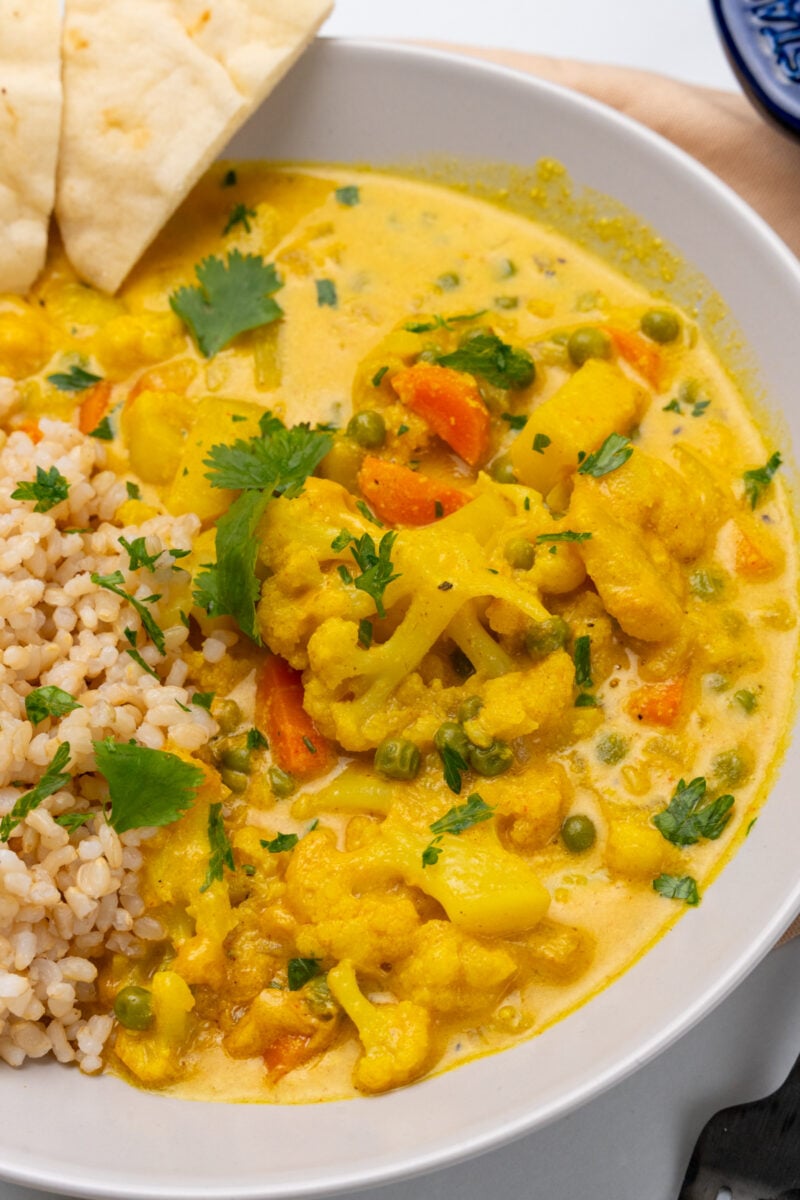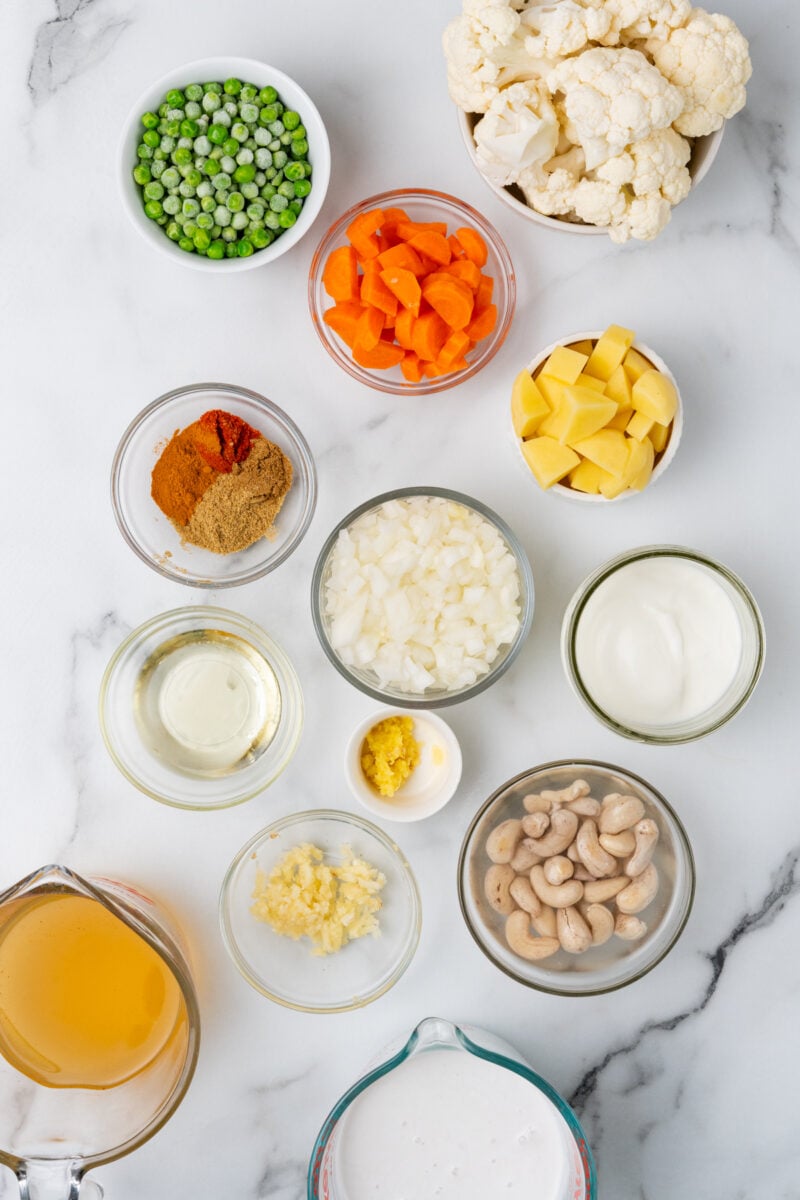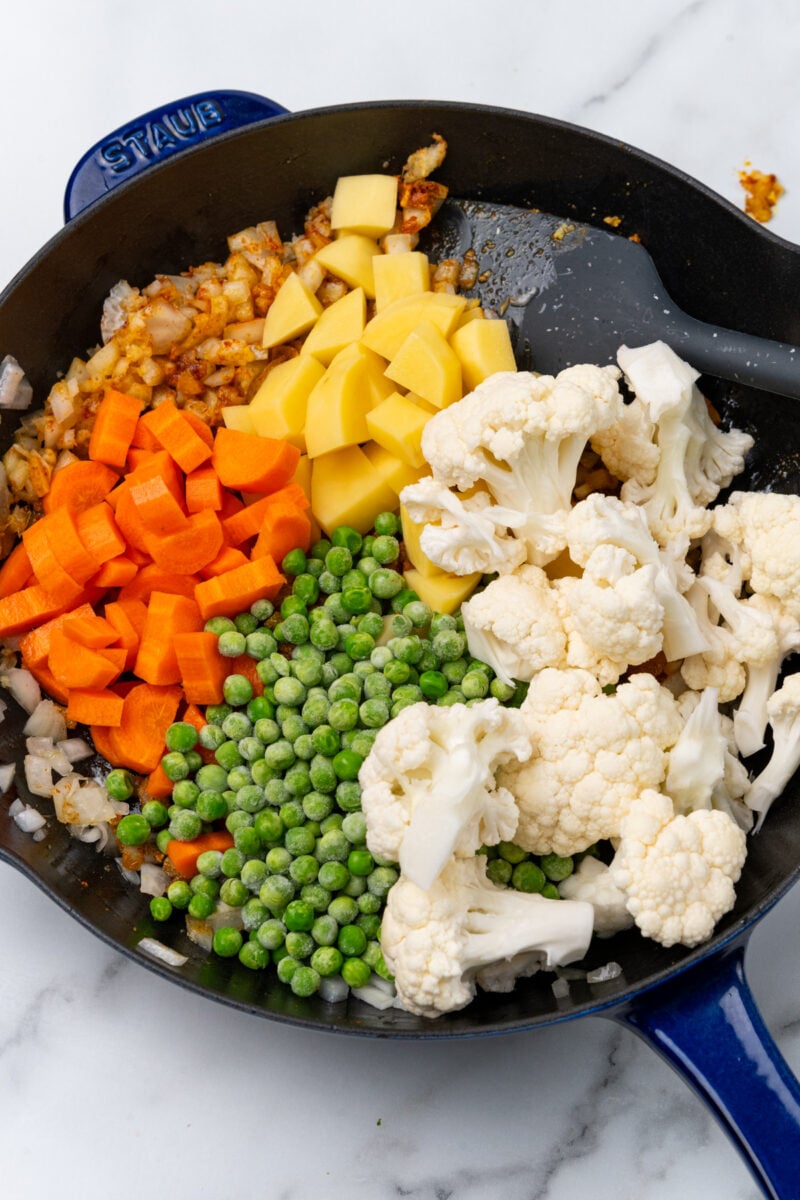Vegetable Korma ⋆ 100 Days of Real Food
This vegetable korma recipe is hearty, savory, creamy, and so flavorful! The veggies are soft and tender. This quick and easy recipe is healthy and nutritious. The flavors are warm and comforting. Great for family dinners, meal prep, and leftovers!
This vegetable korma is hearty, savory, and incredibly flavorful! It contains the rich flavor of fresh vegetables. Packed with a medley of vegetables and a harmonious blend of spices, vegetable korma offers a delicious experience. It is great for weeknight family dinners, entertaining with friends, meal prep, and leftovers. It is both nutritious and delicious!

Why You’ll Love This Recipe
- Vegetable korma is a vegetarian or vegan-friendly dish that celebrates the natural flavors and textures of various vegetables.
- Whether you follow a plant-based diet or simply enjoy exploring new culinary experiences, this is a dish that will satisfy both your taste buds and your nutritional needs.
- Its rich, creamy sauce is a perfect canvas for a variety of vegetables.
- Feel free to customize the dish to your liking.
- The flavors are unique, deep, and savory.
- Great with whole wheat Naan bread, brown rice, or whole wheat noodles.
- This korma recipe is filling and hearty. It will warm you right up!
- This recipe is naturally gluten-free, meatless, and vegetarian. Use dairy-free yogurt to make this recipe vegan and dairy-free.
- Check out Chicken Tikka Masala for another Indian-inspired dinner favorite!
What is Vegetable Korma?
Vegetable korma is an Indian comfort food dish that features a medley of vegetables cooked in a spiced sauce.
The word “korma” originates from the Urdu language, meaning “braising” or “slow-cooking.”
The sauce is typically made with a base of onions, tomatoes, and a variety of spices, which are sautéed until fragrant and then simmered with the vegetables.
The dish can be customized to include your favorite vegetables, such as carrots, peas, potatoes, cauliflower, bell peppers, and more.
Ingredients & Substitutes
Scroll down to the recipe card for the full vegetable korma recipe.
Olive oil helps cook the onions. Feel free to use avocado oil if needed.
Finely chop the onions. They add so much flavor.
Both minced garlic and grated ginger add flavor. Use fresh garlic and fresh ginger.
Cumin, coriander, turmeric, paprika, and cayenne add flavor and spice. Feel free to reduce the amount of paprika and cayenne for a mild flavor.
Carrots, peas, potatoes, and cauliflower are great for this korma dish. Feel free to omit one of these if desired.
Canned coconut milk adds so much creaminess! This is usually found in the Asian aisle at the grocery store. If needed, replace with heavy cream.
Vegetable broth adds a hearty flavor and moisture.
Use plain unflavored yogurt. If desired, use dairy-free yogurt.
Soaked cashews add so much creaminess. Soak for 30 minutes prior to making this recipe. Then, blend until it becomes a paste.
Add salt to taste.
Top with freshly chopped cilantro if desired.
Lastly, serve with cooked brown rice or whole wheat Naan bread.

Taste & Texture
The taste of vegetable korma is a harmonious blend of aromatic spices and creamy coconut milk and yogurt.
The spices, such as coriander, cumin, turmeric, and garam masala, infuse the dish with a warm and complex flavor profile.
The addition of ginger and garlic adds a hint of freshness.
The creaminess of coconut milk and yogurt creates a luscious and velvety texture.
The vegetables retain their vibrant colors and offer a pleasant crunch, perfectly complementing the richness of the sauce.
How to Make
Step 1
First, heat the olive oil in a large skillet over medium heat. Add the chopped onion. Cook for 5 minutes, or until softened.


Step 2
Add the minced garlic and ginger to the pan. Cook for another 1 to 2 minutes, stirring frequently.


Step 3
Stir in the cumin, coriander, turmeric, paprika, and cayenne powder. Cook for 1 minute, until fragrant.


Step 4
Add the diced vegetables to the pan. Stir to coat them in the spices. Cook for 2 to 3 minutes, until veggies start to soften.


Step 5
Next, pour in the coconut milk and vegetable broth. Stir to combine. Bring this to a simmer and cook for 12 to 15 minutes, until veggies have reached desired tenderness.

Step 6
In a blender or food processor, blend the cashews with a little water until it becomes a smooth paste.

Step 7
Add the cashew paste and yogurt to the skillet. Stir together. Cook for 3 minutes, until the flavors meld together.

Step 8
Season with sea salt to taste. Adjust the spices as needed.
Step 9
Finally, remove the pan from the heat. Serve the vegetable korma over cooked brown rice. Garnish with fresh cilantro.

Expert Tips for Success
Sauté the onions well. Take your time when sautéing the onions. Cook them slowly over medium heat until they turn golden brown. This caramelization process will enhance the sweetness and depth of flavor in the dish.
Use a variety of vegetables. Experiment with different vegetables to add variety and color to your vegetable korma. Consider using carrots, peas, potatoes, cauliflower, bell peppers, green beans, or any other vegetables of your choice. This will make the dish visually appealing and provide a range of textures.
Do not overcook the vegetables. While it is important to cook the vegetables until they are tender, be mindful not to overcook them. Vegetables should retain a slight crunch to add texture and freshness to the dish. Keep an eye on them while simmering in the sauce, ensuring they do not become too mushy.
Experiment with garnishes. Garnishing your vegetable korma with fresh herbs like cilantro or mint leaves adds a burst of freshness.
Additionally, toasted nuts, such as slivered almonds or cashews, provide a delightful crunch and nutty flavor. Feel free to get creative with your garnishes to enhance both the visual appeal and taste of the dish.
Allow the flavors to meld. After cooking, let the vegetable korma sit for a while before serving. This allows the flavors to meld together, resulting in a more balanced and flavorful dish.
Consider making the korma ahead of time and reheating it before serving to allow the flavors to develop even further.
How to Serve & Store
Vegetable korma is best enjoyed with steamed basmati rice or warm Naan bread.
The rice serves as an excellent vehicle to soak up the flavorful sauce, while the Naan bread adds a delightful texture and taste.
You can also serve vegetable korma as a side dish alongside other Indian favorites like dal (lentil curry) or biryani (spiced rice dish).
To store leftovers, allow the dish to cool completely and then transfer it to an airtight container.
Refrigerate for up to 3 to 4 days.
Freeze for up to 2 months.
Frequently Asked Questions (FAQs)
Yes, this recipe uses coconut milk and can be made with dairy-free yogurt. This creates a delicious lactose-free version of classic vegetable korma.
The level of spiciness can be adjusted to suit your preference. I add in all of the spices for a very flavorful dish. If you prefer milder flavors, reduce the amount of cayenne powder and paprika or omit completely.
Yes, this dish is freezer-friendly. Freeze for up to 2 months.

Equipment Needed
Large Nonstick Skillet: This big nonstick pan is large enough for this recipe.
You May Also Enjoy
If you enjoyed this vegetable korma recipe, please leave a rating and comment! For more inspiration, check out my Facebook, Instagram, and Pinterest. For 5 free weekly meal plans and more free resources, sign up to receive my free newsletter! Check out these Dinner Recipes for more healthy and easy family dinner ideas.
Enjoy this vegetable korma recipe!




